The Palmetto Island State Park is terrific both in size and beauty. It’s a diverse forest with, next to our campsite, what looks like the most enormous rhododendron tree I’ve ever seen (it’s a magnolia). At the base are palmettos.

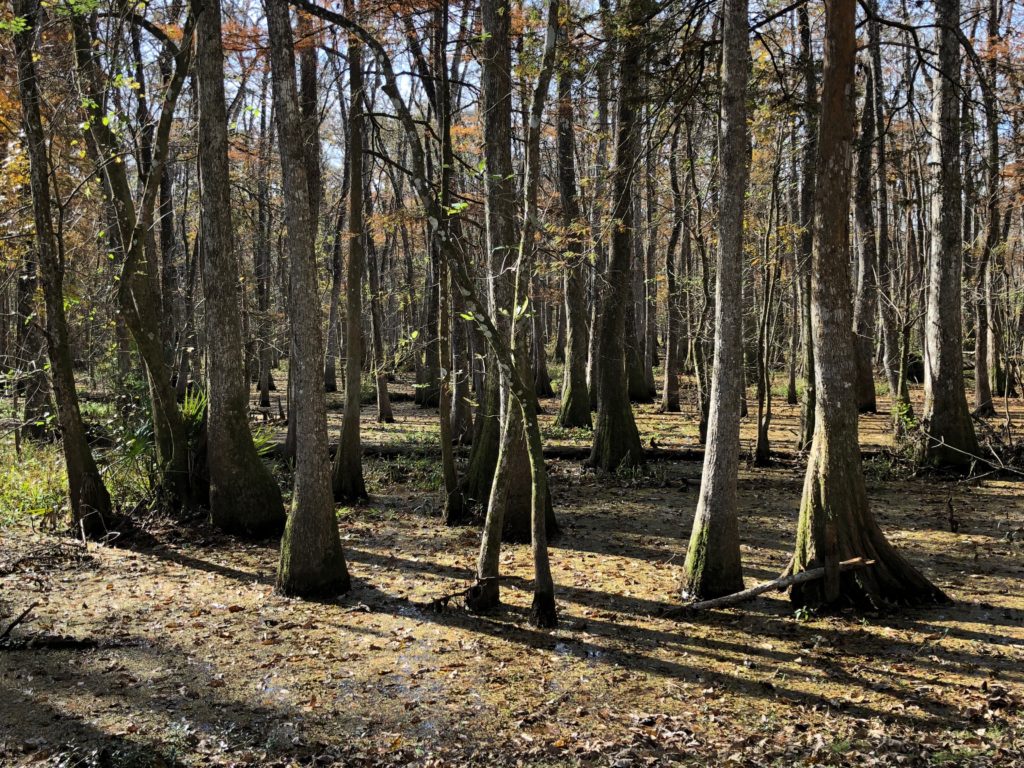
We drive to Abbeville because the Park Ranger recommends a restaurant there. We check out a cultural center dedicated to the Acadians (Cajuns), French speaking catholics who came here after being kicked out of Nova Scotia by the British.
There are many flyers for tourist attractions. One that strikes my eye is about a wilderness tour on a small boat. Felicity eagerly books us for tomorrow afternoon.
The wilderness is a couple of hours from here but there’s a creole restaurant ten minutes away that was even more highly recommended and which sells frozen food, too, so I persuade Felicity to check it out. That’s not hard to do 🙂
The store is a colorful old timey place with a very friendly owner. Felicity makes several tantalizing purchases including turtle gumbo.
We drive back through Abbeville. Many of the fields on the far side are wet. They’ve all been harvested so we can’t tell what they were growing. Then we pass one with Ricetek placards on the fence. Ah, rice.
Further on, the fields are thickly covered with a green plant that grows as high as corn but has no seed heads. It must be sugar cane. Felicity asks Google and learns that a great amount of it is grown around here.
I’ve been looking for several days for an oil change place because we’ve gone almost 4,000 miles since the one when the speedometer was installed. Now I see one and they can do it right away.
When we settle the bill the owner chats with us”
“How long have you been in this area?”
“A couple of days in Louisiana so far; we like it a lot, never been here before.”
“How long will you stay?”
“Probably only a couple more days because we need to get home.”
“Where did you eat last night?”
“Martin can’t swallow so we eat in the camper but I did have lunch out today.”
“Have you tried boudin?”
“What’s that?”
“Well, if I tell you maybe you won’t try it.”
“Is it sausage?”
“It is, they make it from what’s left after a pig is butchered.”
I look enthusiastic and the owner looks very happy about that. He smiles broadly and tells me the best boudin comes from Richard’s Meat Market. It’s in the opposite direction, where we came from in fact, but only ten minutes away. We go, of course, and Felicity indulges me.

It’s just dark when we reach the campsite. Felicity immediately purees one of the sausages for me. I won’t regret this no matter what my stomach makes of it.
This place doesn’t seem to have a name. It’s not far from White Castle, which is the name of my very first meal in the USA. I loved it! I love boudin, too.
Next day – No ill effects from the boudin and the excellent taste is still with me. I’ll have an early lunch today because our wilderness tour starts at 2:30 and I’ll need all my plumbing to be stable.
My all-liquid diet differs from the usual in several ways. One is I never have “I’m hungry” sensations. I wake up knowing but not feeling it’s time to eat. No problem because I can follow routines whose purpose makes sense. Another difference is I have to be careful not to trigger acid reflux by bending. Liquid contents of the stomach can come up my throat much more easily than our usual viscous mix. It’s all just circumstances to manage as much as anything can be managed.
This campsite is utterly different from the State Park one, a concrete slab with sites side by side facing a road. Our host is very friendly and helpful, though. All our interactions in Louisiana have been. We’ve been feeling very positive about our time here, not quite knowing why. We’re sensitive to geography and usually shun flat lands. Maybe the beautiful live oaks account for the difference.
But I think the big factor is, the people we’ve met all seemed happy. I wonder why. It can’t just be the boudin.
We drive down to the general store where we’ll meet our tour guide. We’re very early because we worried we might get lost but it’s a five minute straight shot. Felicity chats with the woman behind the counter. She’s from Vietnam. This is a pretty isolated community but I guess anywhere in America would be strange.
Then we chat with three guys hanging out in front of the store. Two are fishermen, happy that this is the start of crawfish season. The other is a plumber.
Felicity has many questions about sugar cane harvesting, crawfish and other local topics. They’re happy to explain. They’re happy period. The younger fisherman says it’s a good living, this is the most productive place in America for crawfish. You can get 10 lbs a day in a trap and you can pull 200 traps a day, so a metric tonne. Farmers also catch crawfish in traps on the irrigated rice fields. The season lasts about five months and it’s just starting now so prices are high. He gets $3.50/lb now. That will drop to $1.50.
Our friendly and knowledgeable tour guide studied wetland environments at LSU. Felicity tells him we hope to see an alligator. It’s probably too cold for adults but there might be a younger one.
We see great blue herons, great egrets, bald eagles and anhinga. Then he spots an alligator, two to three feet long, floating almost submerged, motionless. It’s farm raised, he says. You can tell because it has a notch cut in its tail. They’re raised from eggs that wouldn’t have hatched in the wild.
There are also squirrels, raccoons, deer, bears, armadillos and nutria. The nutria were imported for their fur, a cheaper alternative to mink.

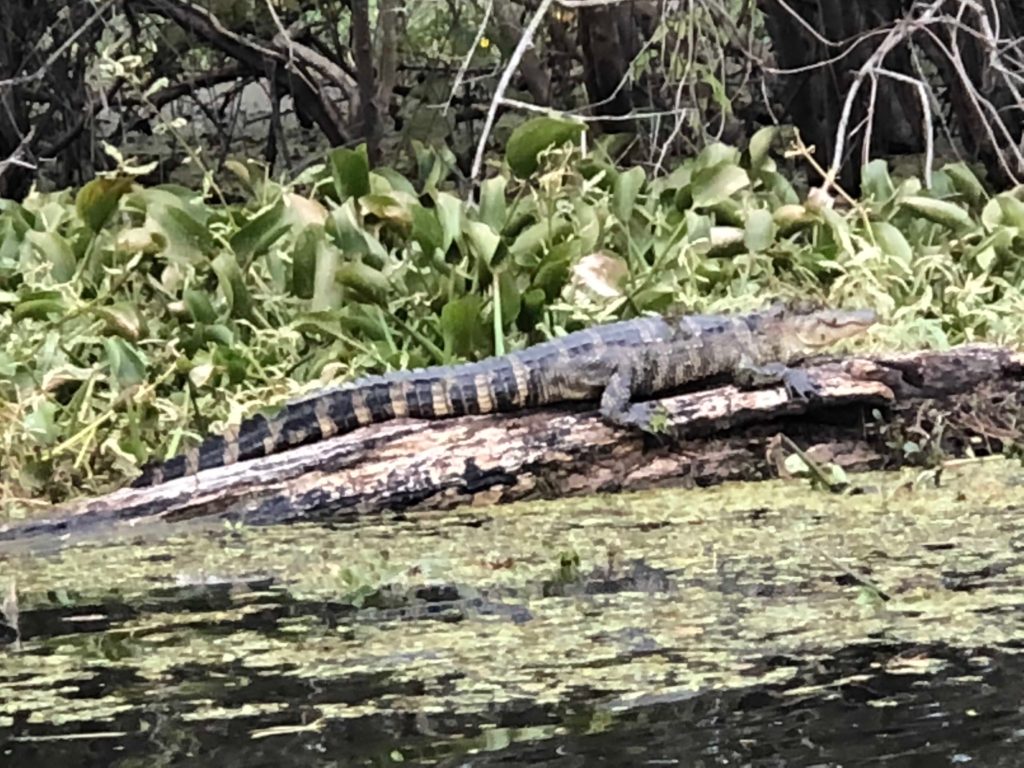
Armadillos can’t swim but they can hold their breath for many minutes. They cross rivers by walking across the bottom. All these creatures have to deal somehow with the flooding and drying of their habitat.
There are big concrete platforms left from when an oil and gas business went bust and several abandoned gas pipeline junction platforms. There’s also an area of dead trees, poisoned by waste dumped by an oil driller. Much of this area is privately owned but there are stronger environmental protections now.
This is part of the Atchafalya Swamp, a huge area that’s part of what used to be a far larger one before the Mississippi was channeled by levies. The water here all comes from that great river and it rises and falls ten feet or more seasonally. The current is fast in the main channels and the water is very muddy.
A century or so ago this whole area was logged. The loggers came in when the water was low, cut the roots around the trees and left them to die so the sap would dry. They came back a year or two later to fell them when they were dry enough to float.
Before the logging this was a climax forest with a 150 foot high canopy. Most of the trees are bald cypress. They’re adapted to life with roots under water. How they get oxygen is an as yet unsolved mystery. A popular theory was recently disproved.

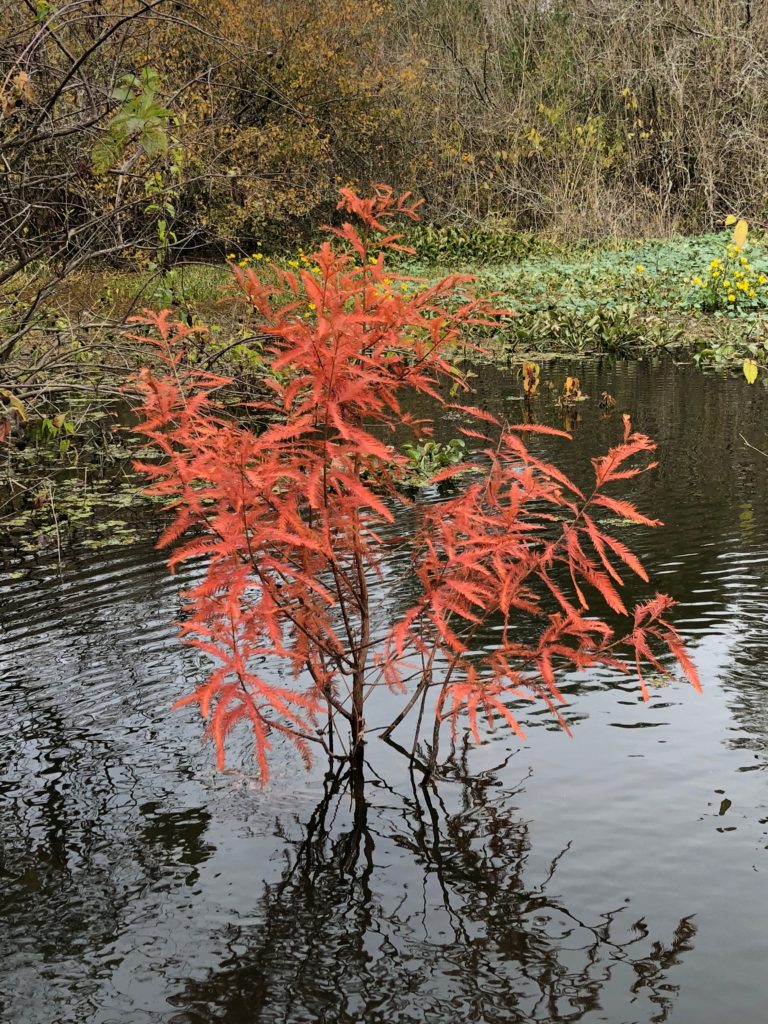
The main channels are wide and around seven feet deep right now. We barrel along at high speed, stopping to watch birds and make side trips into bayous where the water is still. It’s a terrific experience. Our guide enjoys it as much as we do.
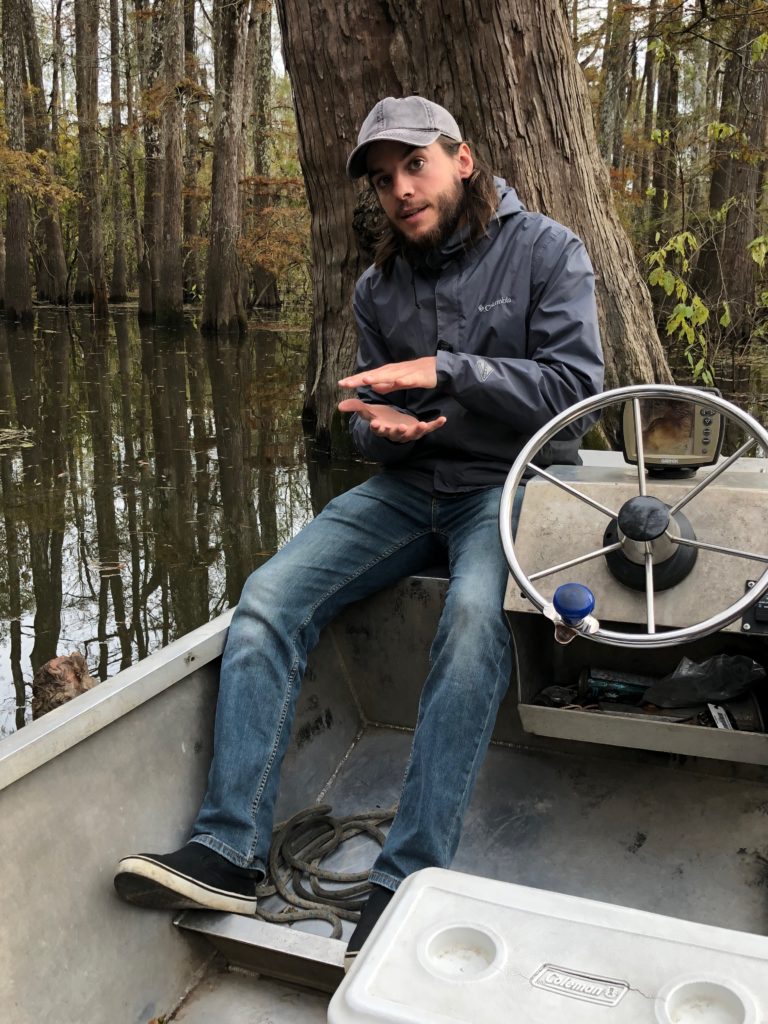
I tell him everyone we’ve met in Louisiana has been friendly and seemed happy. I ask if we’ve just been lucky. He says there are nice people everywhere. Felicity asks follow-up questions and he says he doesn’t know if there’s anything unusual about folks here but it is thinly populated so maybe it’s easier to feel good.
Thinking about it later I suspect the people we’ve met have all been living pretty much the same way all their life. They know what to expect from day to day and year to year. Much less stress than urban life now.
Next day – I wake fighting for breath. My nostrils are blocked. I rip off the BIPAP and slowly recover. Next time I wake, my nostrils are partly clear but I want more air in my lungs so I put the BIPAP on again. I wake fighting for breath again. Next time I wake it’s from a nightmare in which we’d bought a huge house in far worse condition than our current home was and a crew of casual workers were not actually doing any work. When I castigated one they all quit and that’s when I noticed they’d stolen a collection of gold coins.
“Powerful stuff, that boudin” says Felicity but I reckon the heating system filter needs changing. “The one in your BiPap, too” says Felicity. The nightmare comes from T. C. Boyles’ excellent novel about Frank Lloyd Wright’s women and the fires that destroyed his home.
Today we’ll visit plantations. The first is Oak Alley Plantation where a man from a wealthy French family established a sugar cane operation. His wife’s family had fled from Haiti when the slaves revolted against French rule in 1791. Other members of his family included a governor of Louisiana as well as many other politicians and bankers.
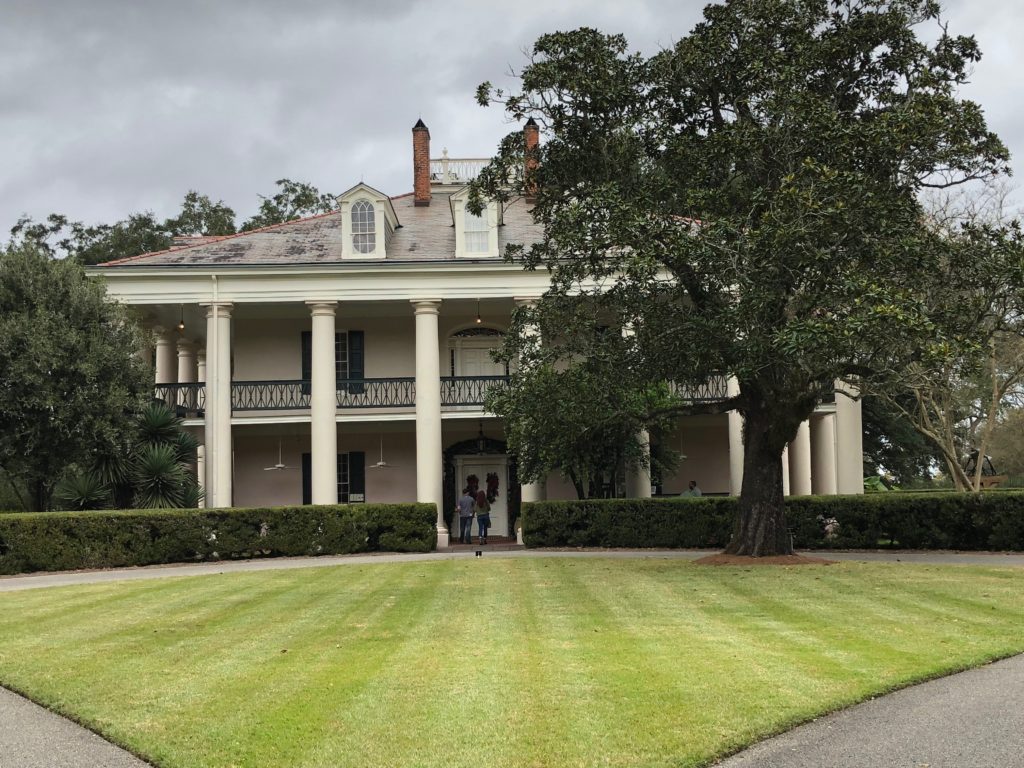
Plantation owners were active in politics because it was important to maintain favorable conditions, including prices, for their crop. “Twas ever thus” as Mr Natural pointed out.
A docent gives us a good overview of the life of domestic and field slaves. Very hard. A second one tells us some family history in the main house and seems relieved when he completes his spiel with very few questions.
Next we visit Laura Plantation, an entirely different evperience. Our guide here is very enthusiastic and enormously knowledgeable. He grew up just a few miles from here and went to college in New Orleans. He loves the smell of the smoke when they burn the cane trimmings after the harvest. If they’d make a candle with that scent, he says, he’d buy their entire inventory.

The plantations all front the Mississippi so they could ship their sugar to New Orleans and the owners could party there. They are long narrow strips that extend far back. Timber was harvested beyond the cane. On some plantations the harvested cane was hauled to the sugar mill by mules over rail tracks.
Harvesting went from the beginning of September to the end of the year and was pretty much a 24/7 operation. The plants harvested first would regrow to a couple of feet high or more by the first frost. An early frost would be a financial disaster.
This plantation made especially enormous profits in the three years following the Civil War. How? The slaves were freed. They could go anywhere they wanted for a better life. Why didn’t they leave?
Slaves were not allowed to learn to read and write. They were barred from any education at all. And they had no money to make moving possible. Their wages were very low and were in the form of scrip to be used at the plantation store where they were caught in a cycle of debt. A few men went to fight for the North. When the war ended they had nowhere to go but back. Many of the slave houses here were occupied until the 1970s.
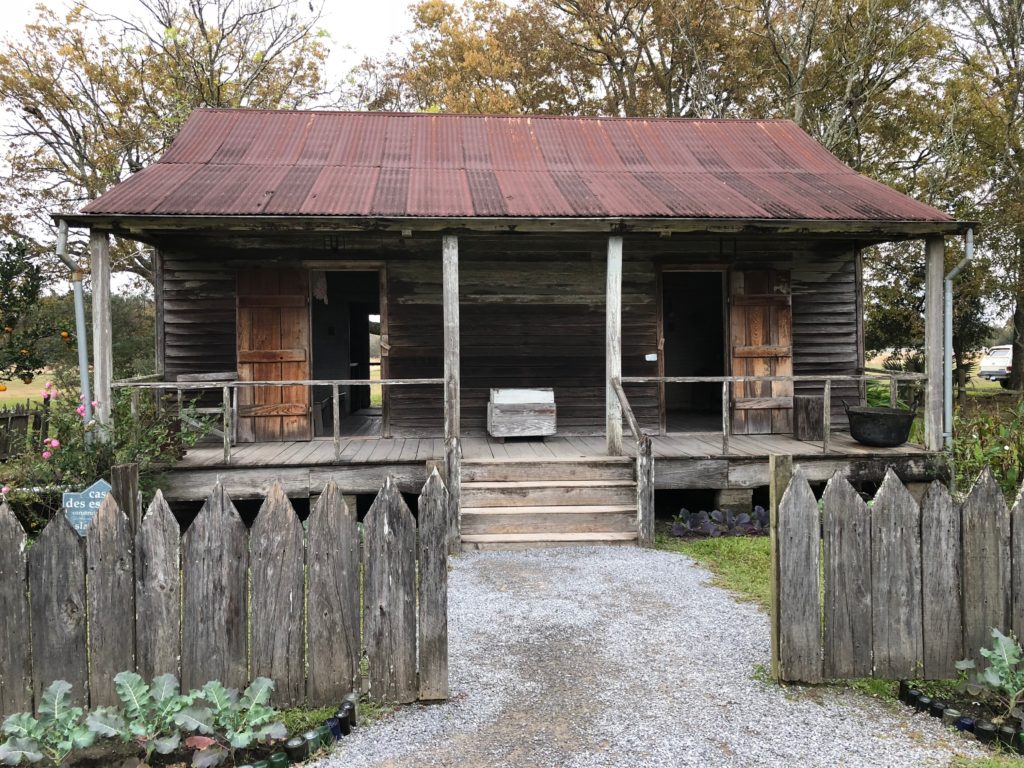
Our first guide at Oak Alley knew a lot because she’d read widely. Our guide here knows far more and there’s nothing academic about it for him. He’s a wiry young white guy whose forbears must have lived not so differently from the slaves. He’s not outraged, just deeply interested in how this society worked and, I’m sure, how it works today. He keeps his opinions about it to himself.
